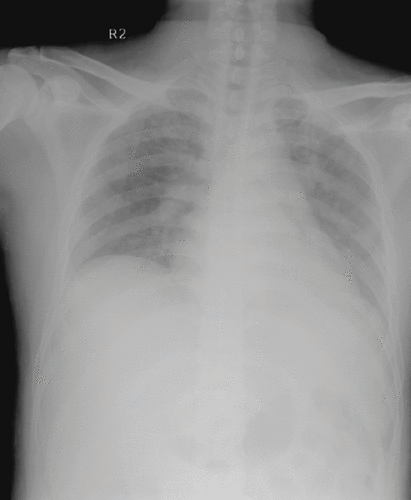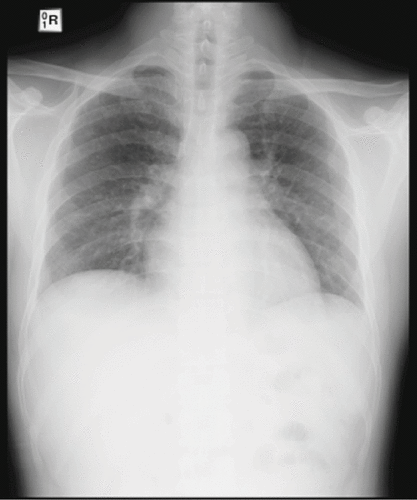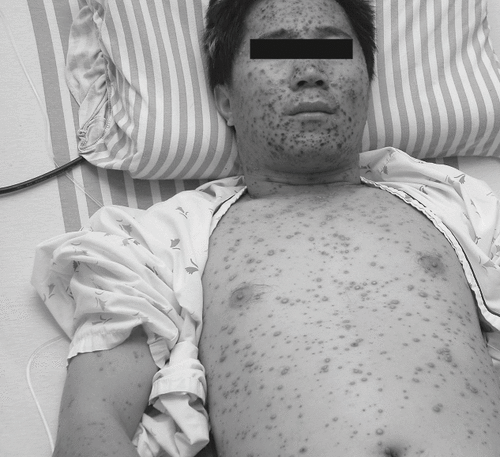Abstract
Primary varicella-zoster (VZ) infection is rare in adults, but the rate of morbidity and mortality is higher than in children. Pneumonia is the most common complication of primary VZ infection in adults. Moreover, varicella pneumonia associated with acute renal failure and acute encephalopathy is very rare. This study reports on a case of disseminated VZ infection successfully treated with acyclovir. The patient was otherwise healthy and denied previous systemic or infectious disease. The initial diagnosis was varicella pneumonia. However, multiple organ involvement subsequently was found in several organs, including the kidney, brain, lung, liver, blood, and skin. The reactivation of VZ infection was strongly suspected. Abnormal renal and liver function and thrombocytopenia also were noted. The patient with chickenpox was treated successfully with acyclovir without complication. In conclusion, multiple organ involvement is a rare complication of VZ infection in adults. In the severe case presented here, adequate intravenous acyclovir administration and close observation of the general condition were essential for successfully treating disseminated VZ infection without complications.
INTRODUCTION
Chickenpox is common and benign in children. Primary varicella-zoster (VZ) infection is rare in adults, but has more than 10 to 20 times the morbidity and mortality rates than in healthy children.Citation[1] Pneumonia is the most common complication of VZ in adults.Citation[2–5] However, multiple organ involvement as a complication of VZ infection in adults is rare.Citation[6–11] This study reports a case of disseminated VZ infection successfully treated with acyclovir.
CASE REPORT
The patient was a 34-year-old man who had good health until one week prior to hospital admission on December 26, 2002, when he began to experienced malaise, low-grade fever, and symptoms of upper respiratory infection. The patient developed a skin rash four days before admission. The rash, characterized by 5–10 mm maculopapules and vesicles with an erythematous base, was first noted on the head and ears and then rapidly spread to the face, neck, trunk, and extremities within one week. Several hundred vesicles were observed. Severe cough and shortness of breath were also noted on the third hospitalization day. The man had no previous memory of chickenpox and was unaware of any recent exposure. The man also had no history of smoking, drinking, drug abuse, or risk factors for human immunodeficiency infection.
The patient was admitted to Chang Gung Memorial Hospital due to general deterioration. On arrival at the emergency room, the patient had a blood pressure of 128/80 mmHg, body temperature of 40.4°C, pulse of 106/min, and respiratory rate of 24/min. Arterial blood gas analysis revealed a pH of 7.451, a partial pressure of carbon dioxide in arterial blood of 29.7 mmHg, and a partial pressure of oxygen in arterial blood of 64.2mmHg on room air. Chest radiograph infiltrated the bilateral lower lung fields (see ). Physical examination revealed coma scales E4V5M6 and general vesicles and pustules over the face, trunk, and four extremities. Moreover, laboratory investigation found glucose 124 mg/dL, serum sodium 139mEq/L, potassium 4.0mEq/L, serum creatinine 0.8 mg /dL, blood urea nitrogen 8 mg/dL, serum alanine aminotransferase 81 U/L (normal, 0–36 U/L), WBC 5250 mm3, segment 74%, platelet 115,000 mm3, hemoglobin 16.1 gm/dL, and hematocrit 45.9%. Finally, urinary analysis showed protein 30 mg/dL, RBC 8–10 high power field, and occult blood 1+. Initial treatment included intravenous acyclovir and antibiotics therapies.
During admission, the patient was disoriented, with a dull response but no neck stiffness. Confused consciousness was noted on the third hospitalization day. Consultation with neurologist led to a diagnosis of central nervous system involvement. Electroencephalography indicated diffuse cortical dysfunction. Brain magnetic resonance imaging found tiny infarcts of left pon. Confused consciousness improved on the seventh hospitalization day. lists laboratory data during admission. Further admission data included amylase 75 U/L, lipase 78 U/L, serum myoglobin 44.2 (normal range <80), no protein or hematuria in urinary analysis, negative HBsAG, negative HCV, negative HIV1+2 AB, positive VZ IgM, and positive VZ IgG. Blood culture revealed no growth. Furthermore, an electrocardiogram revealed sinus tachycardia but was otherwise normal. Renal echo displayed compatibility with acute renal parenchymal disease, the size of the right kidney (12.4 cm), and the size of the left kidney (12.1 cm). Intermittent fever with cough was noted for the initial ten hospitalization days. Respiratory depression didn't occur, and the patient was not intubated. Follow-up chest radiograph indicated improvement of pneumonia (see ) on the seventh hospitalization day. Initial serum creatinine was 0.8 mg/dL and peak creatinine was 4.4 mg/dL. Renal function normalized on the twelfth hospitalization day. Moreover, thrombocytopenia normalized on the eighth hospitalization day. General vesicles and pustules were present over the face, trunk, and four extremities on the seventh hospitalization day (see ). Daily acyclovir 750–1500mg (adjust renal function) was applied for 12 days and then substituted with an oral form of valacyclovir at 1500mg daily for two weeks owing to disseminated VZ infection. Liver function normalized on the fifteenth hospitalization day. Finally, generalized cluster formations over the skin were improving by the 23rd hospitalization day.
Table 1 Laboratory data before and after acyclovir therapy during admission
DISCUSSION
VZ infection is generally very serious in immunocompromised patients. Notably, the reactivation of VZ has been reported in renal transplant recipients.Citation[8] The case presented here had no memory of previous VZ infection and was unaware of any recent exposure. The detection of VZ infection before admission and the lack of VZ IgM antibody indicated that the patient had already acquired VZ infection. The patient was VZ-IgG positive and VZ-IgM positive. The reactivation of VZ infection is likely in this patient.
This study describes VZ infection in a renal transplant recipient associated with abdominal pain, hepatitis, and glomerulonephritis.Citation[12] Acute renal failure as a complication of severe chickenpox has been reported in adults.Citation[6–8] The association between nephritis and VZ dates back at least to 1884, when Henoch described four cases of nephritis in children with chickenpox, in whom proteinuria, hematuria, and edema developed three to eleven days after the skin rash.Citation[13] A literature review in 1929 found 52 cases of acute nephritis associated with chickenpox.Citation[14] Nephritis could be diagnosed clinically in only 0.1 percent of 2534 patients with chickenpox in one study.Citation[15] Renal biopsy reports of nephritic syndrome or of hematuria and azotemia concurrent with VZ infection have displayed a proliferative glomerulonephritis.Citation[16],Citation[17] Renal abnormalities may appear shortly before but generally occur after the appearance of the skin lesions and resolve as the lesions regress. No renal biopsy was performed in the present patient because of only mild proteinuria with hematuria. No leg edema was observed during admission. Mild proteinuria and microscopic hematuria were found on admission. Moreover, abnormal renal function was found on the fifth hospitalization day. Urinary analysis showed no proteinuria or hematuria on the third hospitalization day. Finally, peak serum creatinine level of 4.4 mg/dL normalized to 1.1mg/dL on the twelfth hospitalization day.
Neurological complications of VZ infection have been reported.Citation[9–11] This complication can be mediated via a cytotoxic mechanism owing to tissue damage associated with immune cell responses. These complications tend to occur either toward the end of the disease or one to two weeks after its termination. Acute encephalopathy is a very common neurological complication. The prognosis for complete recovery from central nervous system complication generally is good. In the severe patient considered here, conscious confusion with headache was noted on the third hospitalization day, and complete recovery was achieved by the seventh hospitalization day. The family refused cerebrospinal fluid study. However, brain magnetic resonance imaging study revealed tiny infarcts of the left pon, and electroencephalography revealed diffuse cortical dysfunction. Acute encephalopathy of brain is likely in this patient.
Pneumonia as a severe complication of severe chickenpox has been reported in adults.Citation[2–5],Citation[18] In the present case, parenteral antibiotics therapy, augmentin was administered for seven days, and a follow-up chest radiograph displayed the resolution of lung lesion. Intubation was not performed in the present case.
In conclusion, multiple organ involvement is a rare complication of VZ infection in adults. In the severe case reported here, adequate intravenous acyclovir administration and close observation of the general condition were essential for successfully treating disseminated VZ infection without complications.
REFERENCES
- Lancz G, Specter S. Varicella-zoster virus. Pulmonary infections and immunity, H Chmel, M Bendinelli, H Friedman. Plenum, New York 1994; 317–319
- Weber DM, Pellecchia JA. Varicella pneumonia: study of prevalence in adult men. JAMA. 1965; 192: 572–573
- Triebwasser JH, Harris RE, Bryant RE, Rhoades ER. Varicella pneumonia in adults: report of seven cases and a review of literature. Medicine. 1967; 46: 409–423
- Weinstein L, Meade RH. Respiratory manifestation in chickenpox. Arch Intern Med. 1956; 98: 91–102
- Hunter J, Stott SA. Life-threatening chickenpox pneumonitis in two previously healthy adults. J R Soc Med. 1999; 92: 472–474
- Bernabeu MR, Rubio GE, Navarro FJ, Cano SA, Sanchez GF. Pneumonia and acute renal failure as complication of varicella in adult. Ann Med Intern. 2002; 19: 126–128
- Roberts DE. Varicella-zoster infection, massive rhabdomyolysis, myoglobinuria, and renal failure. J Am Board Fam Pract. 1995; 8: 52–54
- Bourbigot B, Quillien MC, Airiau J, et al. Renal failure in the course of reactivation of varicella-zoster virus infection in a renal transplant recipient. J Infect. 1986; 13: 159–162
- Caruso JM, Tung GA, Brown WD. Central nervous system and renal vasculitis associated with primary varicella infection in a child. Pediatrics. 2001; 107(1)E9
- Shope TC. Chickenpox encephalitis and encephalopathy: evidence for differing pathogenesis. Yale J Biol Med. 1982; 55: 321–327
- Gilden DH, Kleinschmidt-Demasters BK, LaGuardia JJ, Mahalingam R, Cohrs RJ. Neurologic complications of the reactivation of varicella-zoster virus. N Engl J Med. 2000; 342: 635–645
- Os I, Ström EH, Stenehjem A, et al. Varicella infection in a renal transplant recipient associated with abdominal pain, hepatitis, and glomerulonephritis. Scand J Urol Nephrol. 2001; 35: 330–333
- Henoch E. Nephritis nach varicellen. Berl Klin Wschr. 1884; 21: 17
- Denny ER, Baker BM, Jr. Varicella complicated by acute nephritis. Bull Johns Hopkins Hosp. 1929; 44: 201–206
- Bullawa JGM, Wishik SM. Complication of varicella. Am J Dis Child. 1935; 49: 923–926
- Krebs RA, Burvant MU. Nephrotic syndrome in association with varicella. JAMA. 1972; 222: 325–326
- Minkowitz S, Wenk R, Frieman E, Yuceoglu A, Berkovich S. Acute glomerulonephritis associated with varicella infection. Am J Med. 1968; 44: 489–492
- Chou DW, Lee CH, Chen CW, Chang HY, Hsiue TR. Varicella pneumonia complicated by acute respiratory distress syndrome in an adult. J Formo Med Assoc. 1999; 98: 778–782


